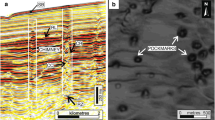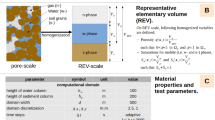Abstract
Marine hydrocarbon gas emissions at an intense, 20-m-deep seep in the Santa Barbara Channel, California were studied with a network of three turbine seep-tents and repeated seabed mapping. The tents observed two gas ejection events that are interpreted as due to blockage of constrictions in fractures and subsequent blow-through. Seabed mapping suggests that very large transient emission events occur, are related to tar, and are temporally and spatially variable. Transient emissions have the potential to more efficiently transport methane to the atmosphere than steady-state emissions. We present an electrical model analog of subsurface seepage useful for seepage flux interpretation. The model predicts that variations in resistance at one vent shifts some of its flux to other connected vents, and that the shift is not zero-sum, i.e., a resistance change at one vent causes a flow change for the overall fracture system.









Similar content being viewed by others
References
Allen AA, Schlueter RS, Mikolaj PG (1970) Natural oil seepage at Coal Oil Point, Santa Barbara, California. Science 170:974–977
Blanchard DC, Syzdek LD (1977) Production of air bubbles of a specified size. Chem Eng Sci 32:1109–1112
Boles JR, Clark JF, Leifer I, Washburn L (2001) Temporal variation in natural methane seep rate due to tides, Coal Oil Point area, California. J Geophys Res 106C11:27077–27086
Cicerone RJ, Oremland RS (1988) Biogeochemical aspects of atmospheric methane. Global Biogeochem Cycles 2:299–327
Clark JF, Leifer I, Washburn L, Luyendyk BP (2003) Compositional changes in natural gas bubble plumes: observations from the Coal Oil Point Seep Field. Geo-Mar Lett 23:187–193
Clark JF, Washburn L, Hornafius JS, Luyendyk BP (2000) Dissolved hydrocarbon flux from natural marine seeps to the southern California Bight. J Geophys Res 105:11509–11522
Clester SM, Hornafius JS, Scepan J, Estes JE (1996) Quantification of the relationship between natural gas seepage rates and surface oil volume in the Santa Barbara Channel. EOS Trans Am Geophys Union 77:420
Clift R, Grace JR, Weber ME (1978) Bubbles, drops, and particles. Academic Press, New York, 380 pp
Crutzen PJ (1995) The role of methane in atmospheric chemistry and climate. In: Engelhardt WV, Leonhardt-Marek S, Breves G, Giesecke D (eds) Ruminant physiology: digestion, metabolism, growth and reproduction. Proceedings of the Eighth International Symposium on Ruminant Physiology. Ferdinand Enke Verlag, Stuttgart, pp 291–315
De Beukelaer SM, Guinnasso NL Jr, MacDonald IR, Murray JA (2003) Distinct side-scan sonar, RADARSAT SAR, and acoustic profiler signatures of gas and oil seeps on the Gulf of Mexico slope. vol 23, pp 177–186
Etiope G, Klusman RW (2002) Geologic emissions of methane into the atmosphere. Chemosphere 49:779–791
Fischer PJ (1978) Natural gas and oil seeps, Santa Barbara Basin, California. California offshore gas, oil, and tar seeps. State Lands Commission, prepared by the Staff of the State Lands Commission, Sacramento, CA, pp 1–62
Fischer PJ, Stevenson AJ (1973) Natural hydrocarbon seeps, Santa Barbara basin, California, Santa Barbara Channel area revisited.
Fischer PJ (ed) Field trip guidebook, vol 3. Am Assoc Petrol Geol, Tulsa, Oklahoma, pp 17–28
Gal-Or B, Waslo S (1968) Hydrodynamics of an ensemble of drops (or bubbles) in the presence or absence of surfactants. Chem Eng Sci 23:1431–1446
Hornafius JS, Quigley D, Luyendyk BP (1999) The world’s most spectacular marine hydrocarbon seeps (Coal Oil Point, Santa Barbara Channel, California): quantification of emissions. J Geophys Res 104:20703–20711
Hovland M, Judd AJ, Burke RA (1993) The global flux of methane from shallow submarine sediments. Chemospheres 26:559–578
Judd AG, Hovland M (1992) The evidence of shallow gas in marine sediments. Cont Shelf Res 12:1081–1095
Judd AG, Hovland M, Dimitrov LI, Garcia GS, Jukes V (2002) The geological methane budget at Continental Margins and its influence on climate change. Geofluids 2:109–126
Katz ME, Pak DK, Dickens GR, Miller KG (1999) The source and fate of massive carbon input during the latest Paleocene thermal maximum. Science 286:1531–1533
Kennett JP, Cannariato KG, Hendy IL, Behl RJ (2000) Carbon isotopic evidence for methane hydrate instability during quaternary interstadials. Science 288:128–133
Kennett JP, Cannariato KG, Hendy IL, Behl RJ (2003) Methane hydrates in Quaternary climate change: the clathrate gun hypothesis. AGU Washington, vol. 54, 216 pp
Kvenvolden KA, Reeburgh WS, Lorenson TD (2001) Naturally occurring methane seepage—workshop report. EOS 82:457
La Montagne MG, Leifer I, Bergmann S, Vandewerfhorst LC, Holden PA (2004) Bacterial diversity in marine hydrocarbon seep sediment. Environ Microbiol (in press)
Leifer I, Boles J (2004a) Turbine seep-tent measurements of marine hydrocarbon seep forcing on sub-hourly time scales. J Geophys Res (in press)
Leifer I, Boles J (2004b) Measurement of hydrocarbon flow through fractured rock and unconsolidated sediment of a marine seep. Marine Petroleum Geology (in press)
Leifer I, Clark J, Chen R (2000b) Modifications of the local environment by a natural marine hydrocarbon seep. Geophys Res Lett 27:3711–3714
Leifer I, Clark JF (2002) Modeling trace gases in hydrocarbon seep bubbles: application to marine hydrocarbon seeps in the Santa Barbara Channel. Russ Geol Geophys (English translation published by the American Geophysical Union) 47:572–579
Leifer I, Clark JF, Luyendyk B, Valentine D (2003) Identifying future directions for subsurface hydrocarbon migration research. EOS 84:364–371
Leifer I, Judd AG (2002) Oceanic methane layers: a bubble deposition mechanism from marine hydrocarbon seepage. Terra Nova 16:471–425
Leifer I, Luyendyk BP, Broderick K (2004) Tracking an oil slick through an area with multiple natural sources, Coal Oil Point, California. AAPG Memoir (submitted)
Leifer I, MacDonald I (2003) Dynamics of the gas flux from shallow gas hydrate deposits: interaction between oily hydrate bubbles and the oceanic environment. Earth Planet Sci Lett 210:411–424
Leifer I, Patro R (2002) The bubble mechanism for transport of methane from the shallow seabed to the surface: a review and sensitivity study. Cont Shelf Res 22:2409–2428
Leifer I, Patro R, Bowyer P (2000a) A study on the temperature variation of rise velocity for large clean bubbles. J Atmos Ocean Tech 17:1392–1402
MacDonald IR, Boland GS, Baker JS, Brooks JM, Kennicutt II MC, Bidigare RR (1989) Gulf of Mexico chemosynthetic communities II: spatial distribution of seep organisms and hydrocarbons at Bush Hill. Mar Biol 101:235–247
MacDonald IR, Buthman DB, Sager WW, Peccini MB, Guinasso Jr NL (2000) Pulsed flow of oil from a mud volcano. Geology 28:10907–10910
MacDonald IR, Leifer I, Sassen R, Stine P, Mitchell R, Guinasso Jr N (2002) Transfer of hydrocarbons from natural seeps to the water column and atmosphere. Geofluids 2:95–107
Mader HM, Brodsky EE, Howard D, Sturtevant B (1997) Laboratory simulations of sustained volcanic eruptions. Nature 388:462–464
McDougal TJ (1978) Bubble plumes in stratified environments. J Fluid Mech 4:655–672
Mikolaj PG, Ampaya, JP (1973) Tidal effects on the activity of natural submarine oil seeps. Mar Tech Soc J 7:25–28
Milkov AV (2000) Worldwide distribution of submarine mud volcanoes and associated gas hydrates. Mar Geol 167:29–42
Milkov AV, Sassen R, Apanasovich TV, Dadashev FG (2003) Global gas flux from mud volcanoes: a significant source of fossil methane in the atmosphere and the ocean. Geophys Res Lett 30:1037–1038
Orphan VJ, Goffredi SK, Delong EF, Boles JR (2003) Geochemical influence on diversity and microbial processes in high-temperature reservoirs. Geomicrobiol J 20:295–311
Patro RK, Leifer I, Bowyer P (2001) Better bubble process modeling: improved bubble hydrodynamics parameterisation. In: Donelan M, Drennan W, Salzman ES, Wanninkhof R (eds) Gas transfer and water surfaces, vol. 127. AGU Monogr, pp 315–320
Prather M, Derwent R, Ehhalt D, Fraser P, Sanhueza E, Zhou X (1995) Other trace gases and atmospheric chemistry. In: Houghton JT, Meira Filho LG, Bruce J, Lee H, Callander BA, Haites E, Harris N, Maskell (eds) Climate change 1994: radiative forcing of climate change and an evaluation of the IPCC IS92 emission scenarios. Cambridge University Press, Cambridge, pp 73–126
Quay P, Stutsman J, Wilbur D, Snover A, Dlugokencky E, Brown T (1999) The isotopic composition of atmospheric methane. Global Biogeochem Cycles 13:445–461
Quigley DC, Hornafius JS, Luyendyk BP, Francis RD, Clark J, Washburn L (1999) Decrease in natural marine hydrocarbon seepage near Coal Oil Point, California, associated with offshore oil production. Geology 27:1047–1050
Rehder G, Brewer PW, Peltzer ET, Friederich G (2002) Enhanced lifetime of methane bubble streams within the deep ocean. Geophys Res Lett 29:1731–1746
Rehder G, Keir RS, Suess E, Rhein M (1999) Methane in the northern Atlantic controlled by microbial oxidation and atmospheric history. Geophys Res Lett 26:587–590
Rowland FS (1985) Methane and chlorocarbons in the earth’s atmosphere. Origins of Life 15:279–297
Sassen R, Milkov A, Ozgul E, Roberts HH, Hunt JL, Beeunas MA, Chanton JP, DeFreitas DA, Sweet S (2003) Gas venting and subsurface charge in the Green Canyon area, Gulf of Mexico continental slope: evidence of a deep bacterial methane source? Organic Geochem 34:1455–1464
Slauenwhite DE, Johnson BD (1999) Bubble shattering: differences in bubble formation in fresh water and seawater. J Geophys Res 104:3265–3276
Sokolov VA, Buniat-Zade ZA, Geodekian AA, Dadashev FD (1969) The origin of gases and mud volcanoes and the regularities of their powerful eruptions. In: Schenk PA, Havenaar I (eds) Advances in geochemistry. Pergamon, Oxford, pp 473–484
Tryon MD, Brown KM, Torres ME, Trehu AM, McManus J, Collier RW (1999) Measurements of transience and downward fluid flow near episodic methane gas vents, Hydrate Ridge, Cascadia Geol 27:1075–1078
Tsunogai U, Yoshida N, Ishibashi J, Gamo T (2000) Carbon isotopic distribution of methane in deep-sea hydrothermal plume, Myojin Knoll Caldera, Izu-Bonin arc: implications for microbial methane oxidation in the oceans and applications to heat flux estimation. Geochim Cosmochim Acta 64:2439–2452
Valentine DL, Blanton DC, Reeburgh WS, Kastner M (2001) Water column methane oxidation adjacent to an area of active hydrate dissociation. Eel River Basin. Geochim Cosmochim Acta 65:2633–2640
Wanninkhof R (1992) Relationship between wind speed and gas exchange over the ocean. J Geophys Res 97C5:7373–7382
Washburn L, Clark JF, Kyriakidis P (2004) The spatial scales, distribution, and intensity of natural marine hydrocarbon seeps near Coal Oil Point, California. Marine Petroleum Geology (in press)
Washburn L, Johnson L, Gotschalk CG, Egland ET (2001) A gas-capture buoy for measuring bubbling gas flux in oceans and lakes. J Atmos Oceanic Tech 18:1411–1420
Watanabe S, Tsurushima N, Kusakabe M, Tsunogai S (1995) Methane in Izena Cauldron, Okinawa Trough. J Oceanogr 51:239–255
Woolf DK, Thorpe SA (1991) Bubbles and the air-sea exchange of gases in near saturation conditions. J Mar Res 49:435–466
Acknowledgments
We would like to thank the support of the U.S. Mineral Management Service, Agency #1435-01-00-CA-31063, Task #18211 and the University of California Energy Institute. Special thanks to University of California, Santa Barbara (UCSB) divers Shane Anderson, Dave Farrar, Dennis Divins, and underwater videographer Eric Hessel. The views and conclusions in this document are those of the authors and should not be interpreted as necessarily representing the official policies, either expressed or implied of the U.S. government or UCSB.
Author information
Authors and Affiliations
Corresponding author
Rights and permissions
About this article
Cite this article
Leifer, I., Boles, J.R., Luyendyk, B.P. et al. Transient discharges from marine hydrocarbon seeps: spatial and temporal variability. Env Geol 46, 1038–1052 (2004). https://doi.org/10.1007/s00254-004-1091-3
Received:
Revised:
Accepted:
Published:
Issue Date:
DOI: https://doi.org/10.1007/s00254-004-1091-3




